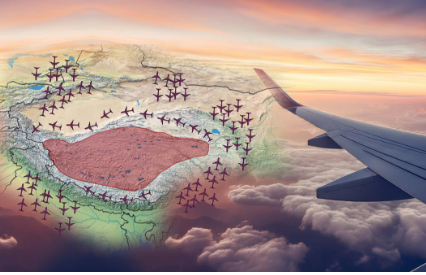Why Planes Avoid the Tibetan Plateau?
The Tibetan Plateau, often called the “Forbidden Plateau,” is a massive region with unique challenges that make it very difficult for airplanes to fly over. Its high altitude, dangerous weather, lack of emergency landing areas, and limited air traffic control all contribute to why airlines avoid this area.
High Altitude
The Tibetan Plateau has some of the highest peaks in the world, with many areas more than 16,000 feet above sea level. At such high altitudes, the air is much thinner, which makes it hard for airplane engines to produce the power needed to stay in the air. Flying over the plateau is like trying to run a marathon at high altitude—it’s exhausting for the plane, and it struggles to stay aloft.
Turbulence
The weather over the Tibetan Plateau is unpredictable and often violent, with strong winds creating severe turbulence. This makes it difficult for pilots to keep the plane stable. Combined with the thin air, these turbulent conditions increase the risks for planes trying to fly over the region.
Lack of Emergency Landing Sites
One of the biggest safety concerns is that there are very few places to make an emergency landing on the Tibetan Plateau. The landscape is rugged, with mountains and steep terrain, and there aren’t many airports or flat areas where a plane could safely land if something went wrong. This lack of emergency options makes it too risky for airlines to send flights over the area.
Air Traffic Control Limitations
The Tibetan Plateau is remote, and because of its harsh environment, there isn’t much air traffic control infrastructure. This makes it harder for pilots to communicate and navigate through the region. Without the support of strong air traffic control, flying over the plateau becomes even more hazardous.
Although the Tibetan Plateau is a fascinating and beautiful part of the world, its difficult geography and extreme weather conditions make it largely inaccessible for airplanes. This region, known for its rich wildlife and cultural history, remains a place of mystery and adventure but is avoided by most airlines due to the serious risks involved in flying over it.
Facts About the Tibetan Plateau
- The Tibetan Plateau is known as the “Roof of the World” because it is the highest and largest plateau on Earth.
- Its average height is more than 4,500 meters (about 14,800 feet) above sea level.
- The plateau spans parts of Tibet, Nepal, India, and China, covering around 2.5 million square kilometers.
- It affects weather patterns in Asia by acting as a barrier to monsoon winds.
- The plateau is home to unique animals, like the Tibetan antelope.
- It holds a large amount of the world’s freshwater, stored in glaciers and frozen ground.
Month: Current Affairs - September, 2024
Category: Science & Technology Current Affairs


